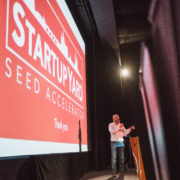The Worst Term Sheet We’ve Ever Seen
Last week we talked about what makes a startup investor “Founder Friendly.” While that’s important to know, it won’t help startups much if they aren’t aware of what the opposite case looks like: when is a term sheet definitively unfriendly to founders?
With this in mind, we polled a collection of investors and lawyers who are friends of StartupYard, and they shared examples with us of the worst term sheets they’ve ever seen, and what was wrong with them. This post should serve as a handy guide to avoiding the worst terms out there.
Too Much Too Early
Several of the respondents noted problems with a company’s early stage valuation, along with protections for both founders and early investors, as a key problem in later rounds.

Chris Kobyletcki, Innovation Nest
“I think it can go both ways. We see investors not taking into account founders for the later-stage investments. Investors take 30-40% of the company at a super-low price that will not leave space for someone new to join the cap table.
The other case is having a super high pre-money valuation that will result in a company not being able to reach the next level of valuation for the next fundraising. I saw multiple cases of rounds falling apart because of that. “ – Chris Kobylecki, VC, InnovationNest

Tytus Cytowski, Cytowski & Partners
“At the Angel Round stage, I have seen CEE angels ask for and receive a board seat, pro rata rights, drag along and protective provisions, which are typical for the series A stage. In general angel should only receive equity without any special rights unless they provide significant assistance to the startup. I have also seen CEE angels and VC investors take up 20-25% of the cap table in exchange for €200K at this stage.” – Tytus Cytowski, Cytowski & Partners

Peter Cowley, Angel Investor
“At the very early stage (ie seed, seed+, A-) sophisticated angels in the UK always offer ordinary shares that are identical to the founders, with no prefs, and no special rights attached to the shares. We do however drag/tag along, pre-emption and other rights and a number of consent rights – see my own term sheet, that I use as the basis of negotiation with founders. This is more a checklist with my suggestions of how the legals should be worded and I am 100% wedded to little of this.” – Peter Cowley, Angel Investor
Cap Table Headaches
Another hot-button issue is the cap table, where founders and investors make mistakes that cause them future problems.

Jaroslav Trojan Equus Ventures
“The most usual scenario is that investors take majority ownership thinking they can ‘control’ the startup. Most of the problems relate to cap table I would say. Also, too many conditional investment tranches are quite a frequent mistake. I also occasionally hear that startups and investors don’t use term sheets at all which may lead to poorly managed round, confusion, and increased legal costs.” – Jaroslav Trojan, Equus Ventures
“One [item I insist on] that strongly surprises founders is reverse vesting, until I have explained to the founders that if one of the founders leaves the business (I have had to negotiate this three times) then their unvested shares are then available to strengthen whatever senior hires are needed to replace the founder If those shares are not used, then the remaining founder owns a bigger share of the pie.” – Peter Cowley
Planning Your Exit
A theme that also emerged in the responses was that founders and investors often fail to plan for the eventuality of an exit, and prepare themselves legally and practically for the eventual sale or liquidation of the investment.
Investors can and do take advantage of the smaller legal resources and lesser experience of startup founders.
“In later stage investments, the big one to watch is (participating or not) liquidation prefs, which if everything goes well, will appear toothless, but if something goes wrong… I was not an investor but there is a 10 figure exit in Cambridge where the founder (having been on the journey for a decade) was squashed to zero by the prefs.” – Peter Cowley
“In a Polish seed VC deal, I saw participating liquidation preferences set at X 2.5 with the preference participating again after payment to founders from the exit. In another deal led by a Polish VC I saw a VC insert a participating liquidation preference while the term sheet called for a non-participating liquidation. In investment agreements I have also seen liquidated damages if founder stops working at the company and/or decides to leave the board of the company. Liquidated damages started at €50K and went upto the size of the round. Standard terms like drag and tag along are often drafted excessively in favor of VC investor.” – Tytus Cytowski
Some less-than-friendly investors can get extremely creative in the ways they ensure they profit most from a startup’s success. As in the above examples, what can appear to be fair on paper can end up costing a founder any chance of profiting from their own work.
To provide some context, a liquidation preference is a clause in an investment contract which ensures that a certain investor receives the profits from any sale of the company first, up to a certain multiple of the original investment. This means that not only does an investor get their share of the company when it is sold, but they may also get more than their original share if the company is sold for less than expected.
For example, if a VC invests €1m at a €4m pre-money valuation, their stake is 20% of the company post-money (€1m out of €5m). If there is a liquidation preference set at 3x, that means that the investor expects to be paid back at least €3m no matter how much the company eventually sells for. If the company sells for €3m, then the VC would take the whole amount, and the founders would have nothing, even though they’d built a company worth €3m.
Often these issues arise because the founders believe that their companies will be worth much more at exit than ends up being the case. A high liquidation preference is not important if the company is worth even more than the multiple of the preference. But if the company sells for less than expected, the investors can take a huge piece (or all) of the proceeds.
Business Culture: Legal Fatigue
One of our own favorite startup lawyers Tytus Cytowski, who has supported our alum Gjirafa Inc. in fundraising, pointed to our regional business culture as an issue:
“Three big picture problems that translate into specific terms. First, CEE investors focus on maximizing control instead of focusing on wealth maximization. The focus on control maximization is a CEE cultural issue caused by lack of trust in entrepreneurs, corporate mentality of investors and the fact that the main LP of the majority of CEE funds is the government.
Silicon Valley on the other hand focuses mainly on wealth maximization and invests with a ‘spray and pray’ mentality. Silicon Valley investors are interested in absolute returns in portfolio, while CEE investors look at returns on the level of each company. The control maximization problem is especially problematic in deals with Polish VCs.
Second, most of the CEE investors have a strong private equity/investment banking background, which does not work well in the startup world. For example, PE/Investment banking is focused on generating fees and strictly growth metrics. Good VCs invest with an understanding of technology, disruption and innovation, not only growth metrics.
Finally, a lot of CEE investors don’t have experience as entrepreneurs and don’t understand the life cycle of a startup and what terms are crucial at each stage. Paradoxically CEE entrepreneurs that become VCs tend to have the most unfriendly startup terms from my experience. In general CEE term sheets are heavy on protective provisions (veto rights), liquidated damages and penalties for founders, drag and tag along, disproportionate equity to risk ratio of startup in favor of investor (above 10 % per round), low valuations. Exception are term sheets from Credo, Reflex and Rockaway, which follow Silicon Valley best practices.” – Tytus Cytowski
That sentiment was strongly echoed by Tudor Stanciu, a startup lawyer and advisor from Romania and former organizer of the HowToWeb conference, who wrote:
 “I think the biggest problem in term sheets is a general one, especially when dealing with corporate VCs / investment arms: the density of language being used. You see 20+ pages of term sheets/SHAs out of which most refer to standard limitation of liability/disclosures that arise from other types of transactions that the VC’s lawyers have done.
“I think the biggest problem in term sheets is a general one, especially when dealing with corporate VCs / investment arms: the density of language being used. You see 20+ pages of term sheets/SHAs out of which most refer to standard limitation of liability/disclosures that arise from other types of transactions that the VC’s lawyers have done.
At least for early stage, pre-revenue startups, founders do not have the ability to reach out to lawyers and pay out fees to get a language-dense SHA cross-checked and simplified by a founder-friendly lawyer, and that can make a founder end up suffering from “contract fatigue” and missing out on important details oft he transaction while wasting time going through lawyer slang and verbose the effect of which is not that significant, in the end.” – Tudor Stanciu, Startup Lawyer
You Need a Lawyer
There’s an old Russian proverb that the writer Suzanne Massie famously quoted to Ronald Reagan in the 1980s, near the end of the Cold War: “Doveryai, no proveryai” or “Trust, but Verify.”
Trust is a tricky thing when it comes to money. There are absolutely people who can be trusted, but how do you recognize them before the fact? It might be that a person left along in a dark room with a pile of cash might be the type who never even thinks of touching it. The problem is you just don’t know until it actually happens.
Certainly we as investors at StartupYard know that we will not, as a matter of practice and principle, deceive or mislead the startups we invest in. We can tell you this until we’re blue in the face, but we have no way of proving it to you except by following through on what we say. When there is a potential for abuse, there is always a risk of abuse. Recognizing that is an important step in maturing as a company founder.
As we have long noted to our own startups and community, when it comes to early stage and Angel investments, the best protection is your network and the good reputation of the investor. However, taking money from an investor without the advice of qualified legal council is a strategic error, even if it may not lead to catastrophe in every case.
Dealing with a bad actor can just be a case of bad luck. We can’t control how lucky we are, but we can control how prepared we are. So there is no excuse not to be prepared.























